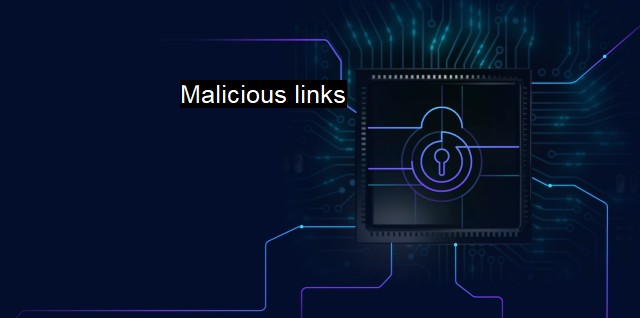What are Malicious links?
Protecting Against the Threat of Malicious Links: Safeguard Your System and Personal Information in Today's Digital Age
The term "malicious links" refers to the interconnected hyperlinks present on the internet that lead users to websites, files, or applications with harmful and unsafe content. These unsolicited links typically aim to compromise or misuse users' personal information or infect their devices with viruses, spyware, trojans or ransomware.A malicious link often works as a primary weapon in a range of cybersecurity assaults. Cyber criminals use diverse strategies to trick users into clicking on the malevolent hyperlink. They may employ strategies such as deceiving messages, emails, instant messages, website comments, or forum posts. These links may appear harmless and legitimate with URLs often appearing to be from trusted sources. This tactic, termed phishing, is often adopted to mislead users, where the cybercriminal mimics the website or the notification messages of reputed banks, financial institutions, or popular social networking sites.
Once a user clicks on a malicious link, various unfavorable actions can happen. It can install malicious software, or malware, onto their device without their knowledge or permission. The harmful software could be varied in nature, including spyware that silently tracks user activities, adware that causes unwanted intrusive ads, viruses that corrupt data, or ransomware that locks access to personal details and demands a ransom for releasing it. The infection typically begins to spread throughout the system silently and elusively, masking its activities from the user and even antivirus software.
Other malicious links direct users to a cloned site impersonating a legitimate site where users are tricked into willingly providing their sensitive details. These websites are deceitful replications of the original ones, designed to fool users into entering their personal details, including bank account details, credit card information, or identity verification details. Cybercriminals can then use this stolen private data for various illegal activities such as identity theft, financial fraud, generating spam or even for selling it further on the dark web.
Malicious links have evolved over time and become increasingly difficult to detect. Cybercriminals often exploit zero-day vulnerabilities (security loopholes not known previously) in widely used software and web browsers, allowing harmful malware to bypass established security barriers unnoticed.
Protecting against malicious links requires multiple precautionary measures. Up-to-date antivirus software programs are immense help in detecting and blocking such harmful links and messages. Many modern antivirus programs have real-time protection features, including phishing and malicious URL blocking, to instantly intercept and neutralize threats before they affect the system.
a robust shield against malicious links also involves cautious user behavior. Users must scrutinize emails or messages carrying the links for any signs of illegitimacy. These signs can range from incorrect grammar or failed personalization in the email to different URL links implied by the visible and actual hyperlinks. Using safe browsing tools, plug-ins, or web services that warn about unsafe links or sites; regularly updating programs; and backup data can provide further safeguarding layers.
It is also crucial to educate and foster a culture of cybersecurity awareness across sectors—from individuals to organizations. From being suspicious about unsolicited communications to double-checking URLs before visiting a website, having a keen eye can safeguard one from the threats of malicious links.
Malicious links are a crucial threat in the complex cybersecurity landscape. With the digital environment becoming integral to aspects of individual lives and global businesses, protection against such links is indispensable. While technology can provide protection to a significant extent, users' actions and awareness greatly determine the battle against malicious links. Empowered people alongside powerful antivirus programs can be a formidable defense to ensure a safe experience in this digital world.

Malicious links FAQs
What are malicious links in cybersecurity?
Malicious links are URLs that are designed to cause harm to a user's computer, mobile device, or network. These links may lead to malware, phishing, or other cyber threats that can compromise your online security.How can I avoid clicking on malicious links?
To avoid clicking on malicious links, you should always check the link's source and verify its authenticity. Be cautious of links contained in suspicious emails, messages, or social media posts, and do not click on links from unknown or untrusted sources. Installing a reliable antivirus software can also help detect and prevent access to malicious links.What are the risks of clicking on malicious links?
Clicking on malicious links can lead to a range of cyber threats, including viruses, spyware, phishing attacks, ransomware, and more. These threats can cause data theft, financial loss, identity theft, or other severe consequences.What should I do if I accidentally click on a malicious link?
If you accidentally click on a malicious link, you should immediately disconnect your device from the internet, run a full virus scan using your antivirus software, and change your passwords for any online accounts that may have been compromised. If you suspect that your personal or financial information has been stolen, you should contact your bank and/or credit card company as soon as possible to report unauthorized charges or transactions.| | A | | | B | | | C | | | D | | | E | | | F | | | G | | | H | | | I | | | J | | | K | | | L | | | M | |
| | N | | | O | | | P | | | Q | | | R | | | S | | | T | | | U | | | V | | | W | | | X | | | Y | | | Z | |
| | 1 | | | 2 | | | 3 | | | 4 | | | 7 | | | 8 | | |||||||